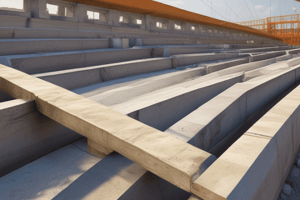Podcast
Questions and Answers
In the context of torsion design, how is a beam idealized according to the text?
In the context of torsion design, how is a beam idealized according to the text?
After cracking in torsion, what primarily provides the torsional resistance in a reinforced concrete beam?
After cracking in torsion, what primarily provides the torsional resistance in a reinforced concrete beam?
What part of the cross section is assumed to provide resistance in the thin-walled tube analogy for torsion design?
What part of the cross section is assumed to provide resistance in the thin-walled tube analogy for torsion design?
How are both hollow and solid sections idealized in torsion design according to the text?
How are both hollow and solid sections idealized in torsion design according to the text?
Signup and view all the answers
What provides the primary torsional resistance in the thin-walled tube analogy for both hollow and solid sections?
What provides the primary torsional resistance in the thin-walled tube analogy for both hollow and solid sections?
Signup and view all the answers
In torsion design, the idealization of a beam as a thin-walled tube is based on which analogy?
In torsion design, the idealization of a beam as a thin-walled tube is based on which analogy?
Signup and view all the answers
When a reinforced concrete beam has cracked in torsion, where is the primary source of torsional resistance located according to the thin-walled tube analogy?
When a reinforced concrete beam has cracked in torsion, where is the primary source of torsional resistance located according to the thin-walled tube analogy?
Signup and view all the answers
How are hollow and solid sections typically idealized in torsion design according to the text?
How are hollow and solid sections typically idealized in torsion design according to the text?
Signup and view all the answers
Which component is neglected in the thin-walled tube analogy for torsion design?
Which component is neglected in the thin-walled tube analogy for torsion design?
Signup and view all the answers
After cracking in torsion, what primarily contributes to the torsional resistance in a reinforced concrete beam?
After cracking in torsion, what primarily contributes to the torsional resistance in a reinforced concrete beam?
Signup and view all the answers
Study Notes
Torsion Design Idealization
- Beams are idealized as thin-walled tubes for torsion design.
- The thin-walled tube analogy is used to idealize both hollow and solid sections.
- The shear flow in the wall of the tube provides the primary torsional resistance for both hollow and solid sections.
- For solid sections, the core of the section is assumed to contribute negligibly to the torsional resistance.
- In the thin-walled tube analogy, the shear flow in the wall of the tube is the primary source of torsional resistance after cracking in torsion.
Torsional Resistance in Reinforced Concrete Beams
- After cracking in torsion, stirrups primarily provide the torsional resistance in reinforced concrete beams.
- The primary source of torsional resistance in a cracked beam is the shear flow in the stirrups, according to the thin-walled tube analogy.
Studying That Suits You
Use AI to generate personalized quizzes and flashcards to suit your learning preferences.
Description
Learn about the design approach for torsion in reinforced concrete beams, based on a thin-walled tube and space truss analogy. Discover how the torsional resistance is primarily provided by closed stirrups and longitudinal bars near the surface of the member.




